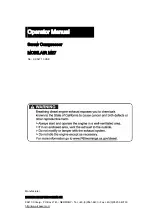
- 9 -
SAFETY DURING TRANSPORT AND
INSTALLATION
When towing, lifting or transporting the compressor
in any way, the battery switch must always be in the
“OFF” position!
To lift a unit, all loose or pivoting parts, e.g. doors and
towbar, shall first be securely fastened.
Do not attach cables, chains or ropes directly to the
lifting eye; apply a crane hook or lifting shackle
meeting local safety regulations. Never allow sharp
bends in lifting cables, chains or ropes.
Helicopter lifting is not allowed.
It is strictly forbidden to dwell or stay in the risk zone
under a lifted load. Never lift the unit over people or
residential areas. Lifting acceleration and retardation
shall be kept within safe limits.
1 Before towing the unit:
- ascertain that the pressure vessel(s) is (are)
depressurized,
- check the towbar, the brake system and the
towing eye. Also check the coupling of the
towing vehicle,
- check the towing and brake capability of the
towing vehicle,
- check that the towbar, jockey wheel or stand
leg is safely locked in the raised position,
- ascertain that the towing eye can swivel freely
on the hook,
- check that the wheels are secure and that the
tyres are in good condition and inflated
correctly,
- connect the signalisation cable, check all lights
and connect the pneumatic brake couplers,
- attach the safety break-away cable or safety
chain to the towing vehicle,
- remove wheel chocks, if applied, and
disengage the parking brake.
2 To tow a unit use a towing vehicle of ample
capacity. Refer to the documentation of the
towing vehicle.
3 If the unit is to be backed up by the towing
vehicle, disengage the overrun brake mechanism
(if it is not an automatic mechanism).
4 Never exceed the maximum towing speed of the
unit (mind the local regulations).
5 Place the unit on level ground and apply the
parking brake before disconnecting the unit from
the towing vehicle. Unclip the safety break-away
cable or safety chain. If the unit has no parking
brake or jockey wheel, immobilize the unit by
placing chocks in front of and/or behind the
wheels. When the towbar can be positioned
vertically, the locking device must be applied and
kept in good order.
6 To lift heavy parts, a hoist of ample capacity,
tested and approved according to local safety
regulations, shall be used.
7 Lifting hooks, eyes, shackles, etc., shall never be
bent and shall only have stress in line with their
design load axis. The capacity of a lifting device
diminishes when the lifting force is applied at an
angle to its load axis.
8 For maximum safety and efficiency of the lifting
apparatus all lifting members shall be applied as
near to perpendicular as possible. If required, a
lifting beam shall be applied between hoist and
load.
9 Never leave a load hanging on a hoist.
10 A hoist has to be installed in such a way that the
object will be lifted perpendicular. If that is not
possible, the necessary precautions must be taken
to prevent load-swinging, e.g. by using two
hoists, each at approximately the same angle not
exceeding 30° from the vertical.
11 Locate the unit away from walls. Take all
precautions to ensure that hot air exhausted from
the engine and driven machine cooling systems
cannot be recirculated. If such hot air is taken in
by the engine or driven machine cooling fan, this
may cause overheating of the unit; if taken in for
combustion, the engine power will be reduced.
12 Before moving the compressor, switch it off.
13 If the warning light on the ABS module or in the
vehicle lights up, please contact Denyo.
SAFETY DURING USE AND OPERATION
1 When the unit has to operate in a fire-hazardous
environment, each engine exhaust has to be
provided with a spark arrestor to trap incendiary
sparks.
2 The exhaust contains carbon monoxide which is a
lethal gas. When the unit is used in a confined
space, conduct the engine exhaust to the outside
atmosphere by a pipe of sufficient diameter; do
this in such a way that no extra back pressure is
created for the engine. If necessary, install an
extractor. Observe any existing local regulations.
Make sure that the unit has sufficient air intake
for operation. If necessary, install extra air intake
ducts.
3 When operating in a dust-laden atmosphere, place
the unit so that dust is not carried towards it by the
wind. Operation in clean surroundings
considerably extends the intervals for cleaning
the air intake filters and the cores of the coolers.
Содержание DU-190
Страница 1: ...8 Instruction Manual English...
Страница 2: ......
Страница 16: ...16 Main Parts...
Страница 18: ...18 COMPRESSOR REGULATING SYSTEM...
Страница 22: ...22 CONTINUOUS PNEUMATIC REGULATING SYSTEM...
Страница 60: ...60 ELECTRIC SYSTEM Circuit diagram 9829 3801 10...
Страница 61: ...61 Circuit diagram 9829 3801 10...
Страница 62: ...62 ELECTRIC SYSTEM Wire harness 1094 3133 02...
Страница 65: ...65 Maintenance Log Compressor Customer Serial number Service hours Maintenance action Date By initials...
Страница 67: ......
Страница 68: ......










































